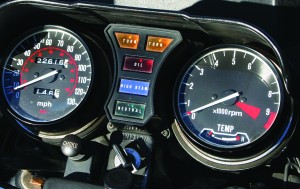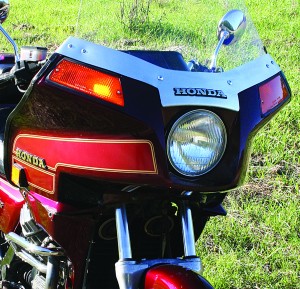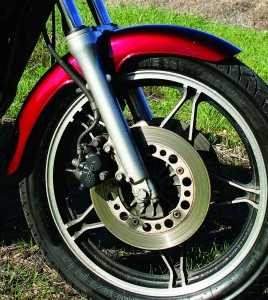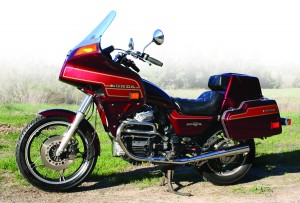Retrospective: Honda GL650I Silver Wing Interstate: 1983
(This Retrospective article was printed in the February 2007 issue of Rider.)
A very sensible motorcycle, this midsize touring bike, but perhaps too sensible for the American buyer.
When you see a hundred or a thousand Gold Wingers together, more than half of them are running solo, and this Silver Wing was a perfect ride for a solo guy or gal. Less expensive and less weight, the 650 Interstate weighed a good 200 pounds less than the 1100 Interstate.
This tale began back in 1978 when Honda introduced the CX500, as useful a motorcycle as one could hope to find. The engine was an 80-degree V-twin (the Moto Guzzi was/is a 90-degree Vee), with short pushrods operating four valves per cylinder, a big bore of 78mm and short stroke of 52mm, a compression ratio of 10:1 and willing to rev to 10,000 rpm. That was impressive! The single camshaft was set high in the block, requiring a Hy-Vo chain with manual tensioning adjustment—the need for which was very infrequent. Valve adjustment was by locknut and screw, with which all the old Brit-bike enthusiasts were quite familiar. Ignition was transistorized and pointless, so to speak. Carburetion was by a pair of big 35mm constant-velocity Keihins. Liquid kept the engine cool rather than air, and the CX500 could sit in traffic on a 100-degree day and not break into a sweat. The power ran through a five-speed transmission to a shaft final drive, very neat and troublefree.
 1983 Honda GL650I Silver Wing Interstate.
1983 Honda GL650I Silver Wing Interstate.
Its frame was the backbone type, using the engine as a stressed member, with a 33mm telescopic fork at the front, a pair of shock absorbers at the back. The ComStar wheels ran tubeless tires, with a drum brake at the back, a disc on the front. The distance between the axles was a leisurely 57 inches. With 4.5 gallons in the tank, the CX tipped the scale at a reasonable 480 pounds.
Reliable horsepower ratings for that time in history are hard to come by, but the CX had in the neighborhood of 40 rear-wheel ponies at 9,000 rpm. Not that many owners were interested in having the engine spin that fast, as it was a bit of a shaker after 7,000 rpm—right where the torque maxed out at 24 lb-ft. This bike turned a respectable 14 seconds in the quarter mile at the drag strip, about half a second slower than the 13.5-second GL1000.
Sales of the CX in Europe were great. This was an eminently practical motorcycle for commuters, for two-wheeled delivery and messenger riders, for the mild-mannered type who liked the charm of two wheels without hassle and botheration. The tubeless tires were a good sales point.
 1983 Honda GL650I Silver Wing Interstate.
1983 Honda GL650I Silver Wing Interstate.
The model had a modest success here; nothing earthshaking like the CB750 of 1969 nor the GL1000 of 1975, but a good platform to be expanded on. Put on a slightly stepped saddle and a smaller tank and call it a Custom. Next move? The factory turned the motor sideways and built a one-off dirt tracker for Freddie Spencer, but that was never going to be a sales success. Perhaps that GL concept …worth looking into.
In 1981 the GL500 did appear as the Silver Wing, with a little 15-liter trunk that fit in place on the back seat for the go-to-work rider. Along with that was the full touring GL500I, I for Interstate like the Gold Wing Interstate, with a fairing and removable saddlebags.
The modular aspect of the luggage was clever, but it meant making a choice—you could either take your loved one or carry close to 30 liters of gear in the big trunk. The smaller commuter box was an option, but if you wanted to go traveling, you might as well go big. Mounting the trunk meant taking off the pillion seat and leaving it in the garage, which should have appealed to wives whose husbands liked to go traveling alone. Without a passenger saddle the tootsie-picking-up-possibilities were limited.
The 25-liter saddlebags could hold a change of clothes. Up front was a biggish frame-mounted fairing, reminiscent of the Vetter Windjammer, with a minimalist 1 inch of adjustment on the windscreen. One nice gadget was the knob for adjusting the headlight while on the bike.
In order to fit those bags in nice and close, as well as to improve handling, Honda decided to toss the twin shocks and go with a single, using the Pro-Link design derived from the motocrossers that provided rising-rate leverage: i.e., the bigger the bump, the stiffer the springing becomes. And the spring support could be enhanced by boosting the air pressure in the shock. Plus the diameter of the new fork legs was expanded to 35mm, and they were air adjustable. The wheelbase was extended by more than an inch.
Honda did some minor fiddles with the engine, claiming more horses, but with all the bodywork and a wet weight of 550 pounds the quarter-mile times went up to 15 seconds. Heck, anyone preferring speed to comfort could get himself a 12-second CB900F.
 1983 Honda GL650I Silver Wing Interstate.
1983 Honda GL650I Silver Wing Interstate.
Somewhere in there Honda decided it would be infinitely cool if the CX were also known as a go-fast kind of motorcycle, and bolted on a turbocharger and fuel injection to the 1982 CX500T. That set the world back on its butt, but the turbocharging craze—which cost all
four Japanese companies millions of unrecouped dollars—was not what the touring rider was interested in.
As an encore Honda figured the company could get inexpensive publicity by boring (82.5mm) and stroking (63mm) the CX/GL500 to 674cc. It was not quite that simple, never was with Soichiro Honda, because he wanted to be absolutely sure that everything in the engine had been strengthened (although much of that work had already been done for the turbo engine). Compression ratio and redline were both lowered a bit, and the factory was claiming 40 lb-ft of torque. The maintenance-friendly aspects of the 500 were made even more friendly on the 650, with an automatic cam-chain adjuster. Without fairing and bags, the Silver Wing could turn 13 seconds in the quarter mile.
 1983 Honda GL650I Silver Wing Interstate.
1983 Honda GL650I Silver Wing Interstate.
But did it sell? No. The whole motorcycle market was depressed, warehouses were filling up everywhere, and prices were being cut beyond the bone. Also, Honda was busily throwing itself body and soul into the V-4 world. The GL650I ended up as a one-year machine, and really cheap new ones could still be found two, three years later. Maybe that is why Honda has refused to bring in its latest midsize touring bike, the Deauville 650, a model that is very popular in Europe.
Honda GL 650
| К странице. |
Мотоциклетное подразделение Honda появилось на свет практически одновременно с автомобильным. Это случилось в середине 40-вых прошлого века. Тогда японская промышленность переживала тяжелые времена, всему виной была Вторая Мировая война.
Основал компанию Соитиро Хонда, который занимался мелкой сборкой зарубежных мотоциклов и производством поршневых колец. Прекрасные конструкторские способности Соитиро сразу же воплощались в жизнь, благодаря чему уже к 60-м годам компания вышла на первые места по продажам мототехники.
Особое внимание японцы уделяли участию их мотоциклов в разных спортивных соревнованиях. Начиная с середины 60-х, хондовские команды неизменно входят в число призеров престижных этапов и гонок.
Среди многочисленной модельной гаммы компании Хонда стоит серия Gold Wing. Это большие мощные мотоциклы туристического направления с большим количеством технических изысков и оборудования для комфортабельных поездок. Первым Голд Вингом был байк с однолитровым силовым агрегатом.
В 1983 году с конвейера сошел более технологичный Honda GL 650. Турерр был доступен в серо-черном исполнении Nimbus Gray Metallic + Achilles Black Metallic и красном Candy Wineberry Red + Bramble Red Metallic. Модель была немного мощнее предшественника, хотя и комплектовалась меньшим по объему силовым агрегатом. 4-тактный, V-образный 2-цилиндровый двигатель имел рабочий объем 674 куб.см.
На каждый цилиндр приходился один распредвал, охлаждение жидкостное. При степени сжатия 9,8 : 1, мотор выдавал максимальные 64 лошадиные силы при 8000 об/мин. Максимальный крутящий момент в 62 Нм. достигается уже при 6000 об/мин. Тормоза байка представляют собой 240-миллиметровый диск спереди и барабанную систему сзади.
Турерр комплектуется телескопической пневматической вилкой. Привод на колесо осуществляется путем карданного вала. На задней подвеске установлена продвинутая система Pro-Link. Максимальная скорость аппарата составляет 175 км/час. Выпуск мотоцикла продолжался недолго, на смену Honda GL 650 пришла целая группа Голд Вингов с разными двигателями от 600 до 1500 куб. см.
Технические характеристики Honda GL 650 1983 года выпуска:
Тип двигателя: 2-цилиндровый, V-образный;
Число цилиндров: 4;
Охлаждение: жидкостное;
Объем двигателя, куб.см: 674;
Мощность двигателя, л.с.: 64;
Трансмиссия: 5-скоростная;
Тип передачи: карданная;
Максимальная скорость байка: км/час: 175;
Тип мотоцикла: туристический круизер.


